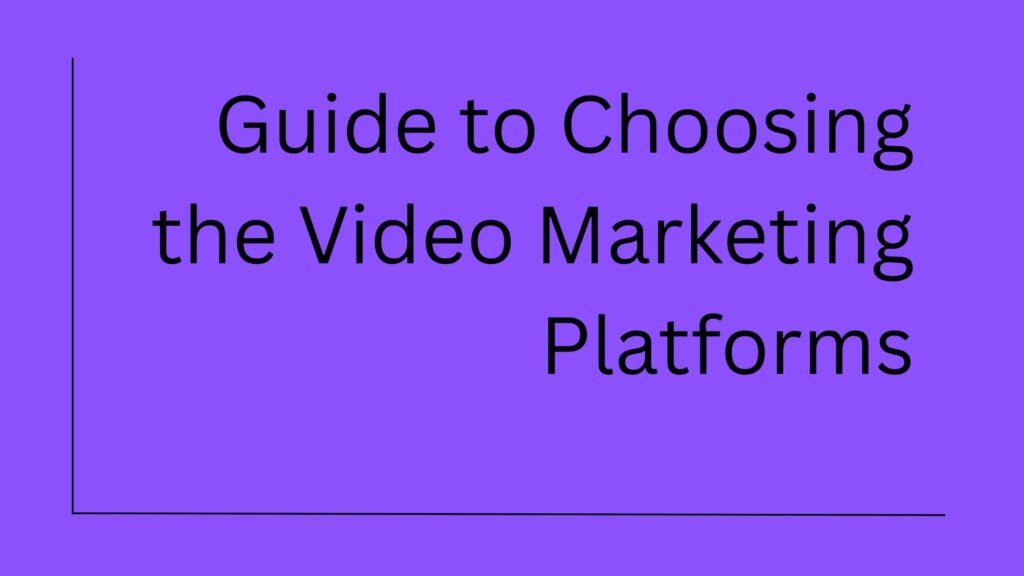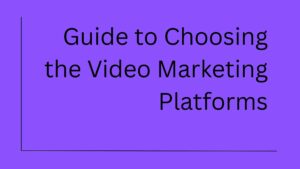Discussing why choosing the best video marketing platforms shouldn’t be as tough as before, because video marketing is everywhere now. Scroll through your phone, and you’ll see more videos than text. Businesses, whether they’re selling beauty products or accounting software, are all trying to figure out where to put their videos. The tricky part is that there isn’t just one platform. There are dozens, and each claims to be the “best.”
Do you pour your energy into YouTube because it feels safe? Do you chase TikTok because it’s hot? Do you focus on LinkedIn if you’re after professionals? The truth is, it depends. What works for one brand can be a waste of time for another.
That’s why you don’t need a “best platforms list.” You need a guide to help you decide which video platforms actually fit your goals, your audience, and your resources. Here are five practical guides to help you make that choice without losing your sanity while you choose the best video marketing platform.
Guide on Choosing the Best Video Marketing Platforms to Grow Your Business
1. Know Your Audience First
This might be the most repeated piece of advice in marketing, but for good reason. If you don’t know your audience, you’ll end up shouting into the void. Platforms are just tools, and the right tool depends on who you’re trying to reach.
If your audience is mostly Gen Z, you’d be making a mistake ignoring TikTok or Instagram Reels. They live there, and they expect brands to show up in creative, fast-moving ways. On the other hand, if you’re targeting senior decision-makers at B2B companies, TikTok clips won’t do much. LinkedIn or YouTube tutorials will.
Ask yourself:
- Where does my audience already spend their time?
- Are they consuming content for entertainment, for learning, or for problem-solving?
- Do they watch in quick bursts on mobile, or are they willing to sit through 10-minute explainers?
Here’s an example: imagine you sell eco-friendly cleaning supplies. If your target is eco-conscious parents, Instagram Reels showing quick hacks could work wonders. But if your target is office managers making bulk purchasing decisions, LinkedIn videos highlighting cost savings and sustainability credentials will be more effective.
One practical way to figure this out is by looking at competitors. Where are they getting engagement? If three out of four of them are putting money into YouTube ads, there’s probably a reason. It doesn’t mean you copy them blindly, but it’s a signal worth paying attention to.
At the end of the day, you can’t market to “everyone.” Get specific about your audience, and the right video marketing platforms start revealing themselves.
2. Match Video Platform Strengths With Your Content
Every platform has its own personality. YouTube is built for depth. TikTok is built for speed. LinkedIn is built for credibility. Too many brands make the mistake of forcing the same video everywhere. It looks lazy, and more importantly, it doesn’t perform.
Here’s a breakdown:
- YouTube is perfect if you can create content that educates, entertains, or tells a longer story. Think tutorials, explainers, customer case studies, or even documentary-style branding. It also works for SEO people who search “how to” and find you.
- TikTok thrives on trends, humor, and quick attention-grabbing clips. A polished 5-minute video won’t work there. But a 20-second “hack” with a catchy sound might.
- Instagram Reels sit somewhere between TikTok and polished marketing. It’s about aesthetics, short stories, and lifestyle content. Perfect for fashion, food, travel, or anything visual.
- LinkedIn video is where you establish authority. Webinars, expert talks, or short industry insights tend to perform better than entertainment. People here are less interested in trends and more in learning something that makes them look smart at work.
- Facebook video still works for community-driven sharing and older demographics. It’s not dead, but it’s not where the cultural wave starts either.
Take an example: if you’re selling fitness gear, your how-to workout guides belong on YouTube. But those same workouts cut down into 30-second bursts with trending sounds could crush it on TikTok. Meanwhile, a brand story about how your equipment is designed with science-backed benefits might live better on LinkedIn.
The key is to play to the platform’s strengths instead of fighting against them. You wouldn’t post a 2,000-word blog on Twitter. So don’t force 10-minute tutorials on TikTok either.
3. Consider Your Marketing Budget and Resources
This one’s easy to underestimate. It’s not just about money; it’s also about time and energy. Each platform has its own rhythm, and if you can’t keep up, your efforts will fall flat.
TikTok and Instagram Reels demand frequency. You can’t post once a month and expect results. YouTube requires quality and consistency. A half-baked video with bad lighting won’t get traction, but a well-edited tutorial could keep earning views for years. LinkedIn may need professional polish or live video setups for webinars.
Now, not every business has a production team. Many small businesses are working with one marketing person, sometimes just the founder. If that’s you, spreading yourself across four platforms will drain you quickly. It’s better to do one or two well than five poorly.
Here’s a practical way to think about it:
- Do I have the skills (editing, scripting, design) in-house?
- What’s my realistic upload frequency?
- Can I afford to boost my content with paid ads if organic reach stalls?
Some brands take the “repurpose” approach. One video gets sliced into multiple pieces: the long version on YouTube, 30-second highlights on Instagram, a quick teaser on TikTok, and a behind-the-scenes clip for Facebook. This saves money and time. Bigger brands, with budgets for separate teams, can create unique content for each.
Don’t underestimate the hidden costs either: captions, thumbnails, editing software, or even just the hours it takes to plan. Video isn’t free, and if you try to stretch thin, the quality dips fast.
So ask yourself: what can we actually sustain? That answer will point you toward the right platform mix.
4. Check Analytics and Measurable ROI
Marketing without tracking results is like driving blindfolded. You might get somewhere, but you’ll crash more often than not. That’s why analytics matter when choosing video platforms.
Some platforms are better than others here. YouTube has one of the most advanced analytics dashboards, showing you audience demographics, watch time, traffic sources, and conversion links. It’s gold for marketers who care about long-term ROI. TikTok gives engagement insights but is more geared toward reach and virality. LinkedIn offers valuable demographic breakdowns, which are critical in B2B marketing.
Ask yourself:
- Can this platform tell me if people are actually watching my videos, not just scrolling past?
- Can I track actions that matter, like clicks to my site, sign-ups, or sales?
- Can I test and adjust based on the data, or is it too limited?
Here’s a simple example: a small online course creator. On YouTube, they can see exactly which tutorials keep viewers watching and which ones make them click out. That tells them what course topics to expand. On TikTok, they might get thousands of views, but if none of those views turn into sign-ups, was it worth the time?
The point isn’t to say one platform is better than another. It’s to be clear on what metrics matter to you. If you’re after brand awareness, TikTok’s reach may be enough. If you’re after leads, YouTube or LinkedIn may prove stronger. Choosing platforms with analytics you can actually use means you’re not wasting time guessing.
5. Think Long-Term Marketing Growth, Not Just Trends
Trends are tempting. Everyone remembers when Clubhouse was supposed to change the world. A year later, it barely comes up in conversations. The same risk applies to video platforms. TikTok is hot now, but will it still dominate in 10 years? Maybe. Maybe not.
On the other hand, YouTube has been here since 2005 and only keeps growing. LinkedIn has been around since 2003 and has slowly become a must for B2B. Platforms with longevity offer something trends don’t: stability. You know your efforts won’t disappear overnight.
This doesn’t mean ignoring trends. Testing TikTok or Instagram Reels can help you stay relevant and reach new audiences. But building your entire video strategy on them? Risky. A smart approach is to mix long-term bets with short-term experiments.
For instance: anchor your content library on YouTube, where videos can live for years and show up in search results. Then, cut snippets of that content for TikTok or Instagram, riding the wave of short-term attention. Meanwhile, use LinkedIn to reinforce your expertise in front of professional audiences.
This way, even if one trendy platform fades, your core presence remains. The last thing you want is to build an entire marketing engine around a platform that shuts down or changes its algorithm overnight.
So when you’re choosing platforms, ask: will this still matter to my business in three years? If the answer feels shaky, don’t make it your foundation.
Final Thoughts
Choosing video marketing platforms isn’t about following hype. It’s about matching your audience, your content, your resources, your metrics, and your long-term goals.
Here’s a quick recap:
- Know your audience. Don’t assume, find out where they are.
- Match your content to platform strengths. Play to the rules, don’t fight them.
- Be realistic about your budget and resources. Don’t burn out.
- Use platforms with solid analytics. Data beats guesswork.
- Balance trends with long-term stability. Don’t bet the farm on what’s hot today.
The smartest brands aren’t everywhere. They’re exactly where their audience is paying attention, and they show up there consistently. If you get that right, you don’t need to chase every shiny new platform; you’ll already be winning with the right ones.





